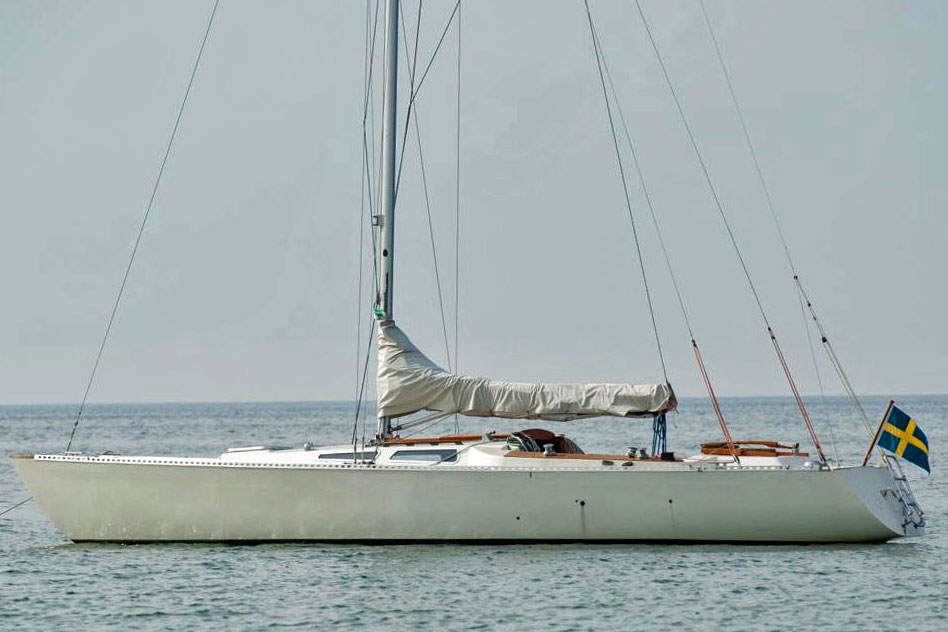- Home
- Cruising Yachts 35' to 40'
- Wasa 30
The Wasa 30 Sailboat
Specs & Key Performance Indicators
The Wasa 30, a 36' light displacement fractionally rigged sloop, was designed by Leif Angermark and built in Sweden by Wasa Marin A.B.
There are two versions of the Wasa 30, the 30HR (High Rig) and the 30LR (Low Rig). 'SysterSol' in the image above and described below, is the 30HR which will account for her high performance.
Published Specification for the Wasa 30
Underwater Profile: Fin keel with spade rudder.
Hull Material: GRP (Fiberglass)
Length Overall: 36'1" (11.0m)
Waterline Length: 29'6" (9.0m)
Beam: 7'3" (2.2m)
Draft: 5'11" (1.8m)
Rig Type: Fractional sloop
Displacement: 5,290lb (2,400kg)
Designer: Leif Angermark
Builder: Wasa Marin A.B. (Sweden)
Year First Built: 1978
Year Last Built: 1980
Number Built: 60
Published Design Ratios for the Wasa 30
Sail Area/Displacement Ratio: 22.2
Ballast/Displacement Ratio: 56.2
Displacement/Length Ratio: 91.7
Comfort Ratio: 18.6
Capsize Screening Formula: 1.7
Summary Analysis of the Design Ratios for the Wasa 30
1. A Sail Area/Displacement Ratio of 22.2 suggests that, in the right hands, the Wasa 30 will have enough performance to leave most other sailboats of similar waterline length well astern.
2. A Ballast/Displacement Ratio of 56.2 means that the Wasa 30 will stand up well to her canvas in a blow, helping her to power through the waves.
3. A Displacement/Length Ratio of just 91.7 places her firmly in the ultralight category, making the Wasa 30 more suited for racing than cruising.
4. Ted Brewer's Comfort Ratio of 18.6 suggests that the Wasa 30 will have the motion underway to that of a lightweight racing boat. Crew comfort will often be memorable for all the wrong reasons. Upwind in lively conditions the Wasa 30 will be tender and slam enough to shake your fillings out with a motion that most cruising sailors have no desire to get used to.
5. The Capsize Screening Formula (CSF) of 1.7 tells us that a Wasa 30 would be a safer choice of sailboat for an ocean passage than one with a CSF of more than 2.0.
The Wasa 30: A Classic Swedish Racer/Cruiser
There are two versions of the Wasa 30: high rig (HR) and low rig (LR), differing in sail area and thus sailing performance. The HR version has a larger mainsail and genoa than the LR version, resulting in a higher speed potential. However, the LR version may be easier to handle and more suitable for cruising.
The Wasa 30 is a rare boat, as only 60 units were built. It is not easy to find one for sale, but if you do, you can expect to pay around $20,000 to $30,000 depending on the condition and equipment.
Accommodation
The Wasa 30 has a simple but functional interior layout that can accommodate up to six people. The main cabin has a U-shaped dinette that can be converted into a double berth on the port side, and a galley with a sink, stove and icebox on the starboard side. There is also a navigation station with a chart table and instruments on the starboard side, next to the companionway.
The forward cabin has a V-shaped double berth with storage lockers underneath. The aft cabin has two single berths with storage shelves above. There is also a head compartment with a marine toilet and a sink on the port side, opposite the aft cabin.
The headroom in the main cabin is about 1.8 meters (5.9 feet), which may be a bit low for some people. The cabin is well-ventilated by four opening ports and two deck hatches. The interior is finished in teak woodwork and blue cushions.
Hull and Deck
The hull of the Wasa 30 is made of fiberglass reinforced plastic (FRP) with a balsa core sandwich construction for stiffness and lightness. The hull shape is inspired by the classical Skerry Cruiser design, which features a long overhang at the bow and stern, a low freeboard, and a narrow beam. The hull is quite flat below the waterline, with a deep fin keel that provides stability and upwind performance.
The deck of the Wasa 30 is also made of FRP with a balsa core sandwich construction. The deck layout is simple and uncluttered, with wide side decks and a spacious cockpit. The cockpit can accommodate four to six people comfortably, and has two large lockers for storage. The cockpit is protected by a sprayhood that can be folded down when not needed.
Mast and Rigging
The mast of the Wasa 30 is made of aluminum alloy and is deck-stepped on a stainless steel compression post that transfers the load to the keel structure. The mast has two sets of spreaders that are swept back at an angle of about 20 degrees. The mast height above waterline is about 14 meters (46 feet) for the HR version and about 13 meters (43 feet) for the LR version.
The rigging of the Wasa 30 is made of stainless steel wire and consists of a forestay, a backstay, two upper shrouds, two lower shrouds, and two intermediate shrouds. The forestay and the backstay are adjustable by turnbuckles. The shrouds are attached to chainplates on the hull sides.
The sails of the Wasa 30 include a mainsail, a genoa, and a spinnaker. The mainsail is hoisted by a halyard on a masthead sheave and is attached to the boom by slides. The mainsail has two reefing points that can be used to reduce the sail area in strong winds. The mainsail is controlled by a mainsheet that runs from the end of the boom to a traveler on the cockpit coaming, and by a vang that runs from the boom to the mast base.
The genoa is hoisted by a halyard on a fractional sheave and is attached to the forestay by a roller furling system. The genoa has a luff length of about 10.5 meters (34 feet) and a foot length of about 5 meters (16 feet) for the HR version, and a luff length of about 9.5 meters (31 feet) and a foot length of about 4.5 meters (15 feet) for the LR version. The genoa is controlled by two sheets that run from the clew to two winches on the cockpit coaming.
The spinnaker is hoisted by a halyard on a masthead sheave and is attached to the mast by a spinnaker pole. The spinnaker has an area of about 60 square meters (646 square feet) for the HR version and about 50 square meters (538 square feet) for the LR version. The spinnaker is controlled by two sheets that run from the clews to two winches on the cockpit coaming, and by two guys that run from the pole ends to two winches on the cabin top.
Keel and Rudder
The keel of the Wasa 30 is a fin keel made of cast iron with a lead bulb at the bottom. The keel has a chord length of about 1.2 meters (3.9 feet) and a depth of about 1.8 meters (5.9 feet). The keel provides stability and upwind performance, but also increases the draft and reduces the shoal water capability.
The rudder of the Wasa 30 is a spade rudder made of FRP with a foam core. The rudder has a chord length of about 0.8 meters (2.6 feet) and a depth of about 1.6 meters (5.2 feet).
This article was written with the assistance of Gemini, a large language model developed by Google. Gemini was used to gather information, summarize research findings, and provide suggestions for the content and structure of the article.
Recent Articles
-
Ohlson 38 Guide: Specs, Performance Analysis & Cruising Review
Jan 07, 26 05:52 AM
Discover the Ohlson 38 sailboat. An in-depth look at its Einar Ohlson design, Tyler GRP construction, performance ratios, and why it remains a top choice for offshore sailors. -
Passoa 47 Sailboat Review: Comprehensive Specs & Performance Analysis
Jan 04, 26 04:57 AM
Discover the Passoa 47, a legendary aluminium blue water cruiser by Garcia. Explore technical specifications, design ratios, and why its lifting keel is a game-changer for offshore sailors. -
Sailboat Wheel Steering Maintenance & Inspection Checklist
Dec 30, 25 02:32 PM
Keep your vessel’s helm responsive and reliable with our expert maintenance checklist. Master cable tensioning and system inspections to avoid mid-passage failures.














